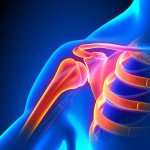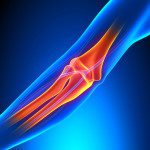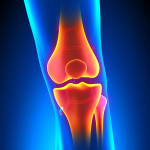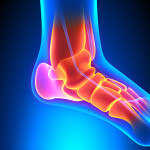The Arms
The upper arm bone fits into a shallow socket on the side of the shoulder blade. As this allows a wide range of movement the shoulder joint is easily subject to body stress. Reaching above the head, stretching the arm backwards, jarring effects in sports like tennis—these actions may strain the ligaments and muscles of the shoulder and tension becomes locked into the joint.
The shoulder may be stiff and painful. If there is a build-up of inflammation the pain may be intense. Most likely the release of the stored tension would have to be carried out several times over a period of time, to enable the joint to stabilize and allow healing to take place.
In a long-term case of body stress of the shoulder the joint may become “frozen,” meaning its mobility is severely restricted. In certain cases, full movement of the shoulder is restored immediately after the stress is released. In other cases, this may occur only after several sessions of BSR. Therefore, to avoid the problem progressing to the stage of immobility, it is advisable to have the shoulder attended to as soon as possible after an injury occurs.
These joints may be stressed by jarring the arm, as in a fall, by twisting movements, such as using a screwdriver or opening a tight jar, by vigorous actions such as scrubbing or using woodworking tools and during athletic events.
Tension can become locked into the elbow joint, between the small wrist bones, or between the hand bones. Carrying heavy shopping bags with the handles looped around the fingers may induce body stress in the joints of the fingers or at the knuckles.
As a result pain or stiffness will be experienced, and possibly numbness or tingling. There may be weakness of the muscles when attempting to lift or grasp an object.
The Legs
The ball-shaped structure at the upper end of the thighbone fits into a deep, secure socket in the pelvis. However, this joint may be stressed by movements such as mounting a bicycle, riding a horse, in a fall, or even from sitting cross-legged when unaccustomed to this position.
As tension becomes locked into the hip joint there may be restricted mobility, a sharp jabbing pain deep in the joint, or a milder ache when walking or dancing.
This joint undergoes a great deal of daily strain, as not only does it bear the weight of the body, it is designed for the flexibility of a hinge joint. The cartilage pad in the knee joint and the ligaments supporting the joint may be stressed by twisting the knee, by jarring it in a fall or in a hard kick.
When there is body stress in the knee, besides being painful, the knee joint may be weakened to the point of collapsing when pressure is exerted on the leg, as in going up or down stairs.
Body stress may become locked into the joints if a person jars or twists the ankle, as in stepping off a pavement incorrectly, or as a result of a kicking action. Besides pain, there may be the sensation of the ankle collapsing when placing the weight of the body on that leg. The joints of the toes may also become stressed and this may in time contribute to the development of a bunion – a distortion of the area of the big toe.
Actual Case Stories
A pianist was aware of a sense of restriction in the palm area of one hand. Body stress was located between the hand bones. A few days after the releases, he reported that the reach of his hand had increased, enhancing his skill in playing the piano.
A woman in her sixties sought BSR care for relief from pain and stiffness in her neck. In the third session she reported that her neck was fully moveable and pain-free, but her left wrist had become painful. She explained that ever since a fall off a horse in her teens she had lost all movement of the wrist.
Body stress tests of the arm revealed tension stored between the bones of the forearm and between the wrist bones. A few days after the releases the pain withdrew and normal movement of the wrist was restored. The client said that she was able to fulfill a lifelong ambition to take up golf.
Note: As the nerve supply to the arms and hands originates from the spinal nerves of the neck, it is essential that any body stress in the neck be released. In many instances, pain, stiffness and numbness in the arm or hand is due to compression in the neck and not to body stress in the arm itself.
A woman in her mid-fifties fractured her ankle. Two years later it was still swollen and stiff, although there was no pain. She was experiencing lower back pain and an ache in the back of her thigh. After body stress was released in the spine over several sessions, the back and leg pain withdrew. No stress was detectable in the ankle. A month later she returned and reported that her ankle had become painful. Body stress was located and released in the ankle and heel regions. By the following day the ankle swelling had subsided and the foot was fully flexible and free of pain. It is significant that the tension stored in the ankle could be located and dealt with only once efficient nerve supply to the area had been restored.
Note: As the nerve supply to the legs and feet originates from the spinal nerves of the lower back, it is vital that any body stress in this area of the spine is released. Very commonly, any pain, stiffness or numbness in the legs or feet is a result of compression in the lower back.




